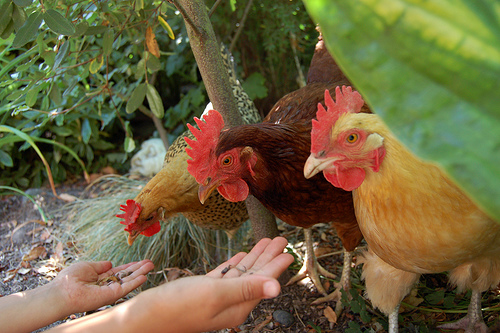The great chicken invasion

In a trend that continues to accelerate, chickens are going mainstream in suburban and urban backyards across the nation.
Citizens are challenging local zoning ordinances, pro-chicken citizens' groups are forming, hatcheries are booming, chicken-inspired small businesses are on the rise, and the local food movement is picking up steam. Even Martha Stewart is a proud owner of suburban chickens.
Esteemed news outlets such as The Wall Street Journal (WSJ) and ABC News are covering the rapidly growing trend. According to the WSJ, membership at BackYardChickens.com has grown from 12,000 in June 2008 to over 60,000 in July 2010. Also, Andy Schneider, the self-proclaimed "Chicken Whisperer" in Georgia, hosts a BlogTalkRadio show that attracts around 15,000 nationwide listeners a month.
According to ABC News, cities such as Seattle, Key West, St. Louis, and Mason City allow pet chickens, though based on anecdotal evidence, hundreds of chicken owners are flying under the radar in other urban and suburban locations. In fact, grassroots organizations such as the Community Led Urban Chicken Movement (CLUC), Coalition of Lawrence Urban Chicken Keepers (CLUCK), Citizens for the Legalization of Urban Chickens in Cedar Rapids (CLUC), and Chicken Owners Outside (and in) Philadelphia (COOP) are fighting for the rights of residential chickens.
The new class of avian pet owners cites a number of factors for the movement's rising popularity. First, even though the movement technically pre-dates the Great Recession, the economic crisis has intensified the need for greater self-sustainability. Second, the organic/local food movement continues to take root in rural, suburban, and urban areas. Third, small-business opportunities are developing. Fourth, it is conducive to a cleaner environment (natural fertilizer, fewer pesticides, smaller carbon footprint, etc). Fifth, the pet birds (mainly hens, since roosters create too much noise) offer an emotional and psychological release from tough economic times and a technologically-saturated existence.
Inquiring minds may also want to know that chickens are genetically, anatomically, and intellectually complex creatures. Like humans, chickens possess about 20,000 genes, and the auditory processing regions of our respective brains are quite similar as well. Not only that, according to a number of animal science experts, chickens are more intelligent than is commonly believed.
Most pundits predict that the great chicken invasion will continue. Despite a bad economy and a techno-obsessed society, it may serve as a much-needed catalyst for frugality, local food, a cleaner environment, entrepreneurship, community camaraderie, and tranquility for the human spirit.



